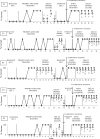The effect of joint control training on the acquisition and durability of a sequencing task
- PMID: 22754104
- PMCID: PMC3363402
- DOI: 10.1007/BF03393107
The effect of joint control training on the acquisition and durability of a sequencing task
Abstract
Gutierrez (2006) experimentally demonstrated the effects of joint control and particularly the role of response mediation in the sequencing behavior of adults using an unfamiliar language. The purpose of the current study was to replicate and extend the procedures used by Gutierrez by comparing the effects of joint control training with the effects of a prompt-and-fade procedure on the acquisition of a sequencing task. The effects of each procedure on delayed sequencing behavior were also tested. Ten undergraduate students participated in 2 experiments. The results indicated that all participants acquired the sequencing response in fewer trials and maintained accurate delayed responding when the component responses necessary for joint control were directly taught. Finally, when the self-echoic mediation component was blocked, accurate responding deteriorated in 8 of 10 participants.
Keywords: echoic; joint control; tact; verbal behavior.
Figures





Similar articles
-
The Effects of Competing Verbal Behavior on Performance in a Math Task.Anal Verbal Behav. 2021 Jun 22;37(1):57-76. doi: 10.1007/s40616-021-00145-6. eCollection 2021 Jun. Anal Verbal Behav. 2021. PMID: 34395166 Free PMC article.
-
The Effects of Blocking and Joint Control Training on Sequencing Visual Stimuli.Anal Verbal Behav. 2016 Nov 4;32(2):242-264. doi: 10.1007/s40616-016-0067-1. eCollection 2016 Oct. Anal Verbal Behav. 2016. PMID: 30800629 Free PMC article.
-
The role of increased exposure to transfer-of-stimulus-control procedures on the acquisition of intraverbal behavior.J Appl Behav Anal. 2012 Winter;45(4):657-66. doi: 10.1901/jaba.2012.45-657. J Appl Behav Anal. 2012. PMID: 23322924 Free PMC article.
-
The Effect of a Mediation-Blocking Task on the Acquisition of Instructive Feedback Targets.Anal Verbal Behav. 2019 Oct 30;35(2):113-133. doi: 10.1007/s40616-019-00119-9. eCollection 2019 Dec. Anal Verbal Behav. 2019. PMID: 31976226 Free PMC article.
-
Comparing mand training and other instructional methods to teach a foreign language.J Appl Behav Anal. 2019 Jul;52(3):652-666. doi: 10.1002/jaba.564. Epub 2019 Apr 24. J Appl Behav Anal. 2019. PMID: 31016726
Cited by
-
The Emergence of Inner Speech and Its Measurement in Atypically Developing Children.Front Psychol. 2020 Mar 17;11:279. doi: 10.3389/fpsyg.2020.00279. eCollection 2020. Front Psychol. 2020. PMID: 32256423 Free PMC article. Review.
-
The Effect of Joint Control Training on the Performance of Multiply Controlled Behavior: A Systematic Literature Review Relevant to Children With Autism Spectrum Disorder and Other Developmental Disabilities.Anal Verbal Behav. 2019 Aug 29;35(2):149-171. doi: 10.1007/s40616-019-00116-y. eCollection 2019 Dec. Anal Verbal Behav. 2019. PMID: 31976228 Free PMC article.
-
Authorship Trends in The Analysis of Verbal Behavior: 1982-2016.Anal Verbal Behav. 2017 Mar 31;33(1):117-138. doi: 10.1007/s40616-017-0076-8. eCollection 2017 Jun. Anal Verbal Behav. 2017. PMID: 30854290 Free PMC article.
-
The Effects of Competing Verbal Behavior on Performance in a Math Task.Anal Verbal Behav. 2021 Jun 22;37(1):57-76. doi: 10.1007/s40616-021-00145-6. eCollection 2021 Jun. Anal Verbal Behav. 2021. PMID: 34395166 Free PMC article.
-
A Bibliographic Tribute to Jack Michael.Anal Verbal Behav. 2016 Nov 23;32(2):275-323. doi: 10.1007/s40616-016-0073-3. eCollection 2016 Oct. Anal Verbal Behav. 2016. PMID: 30800631 Free PMC article.
References
LinkOut - more resources
Full Text Sources

